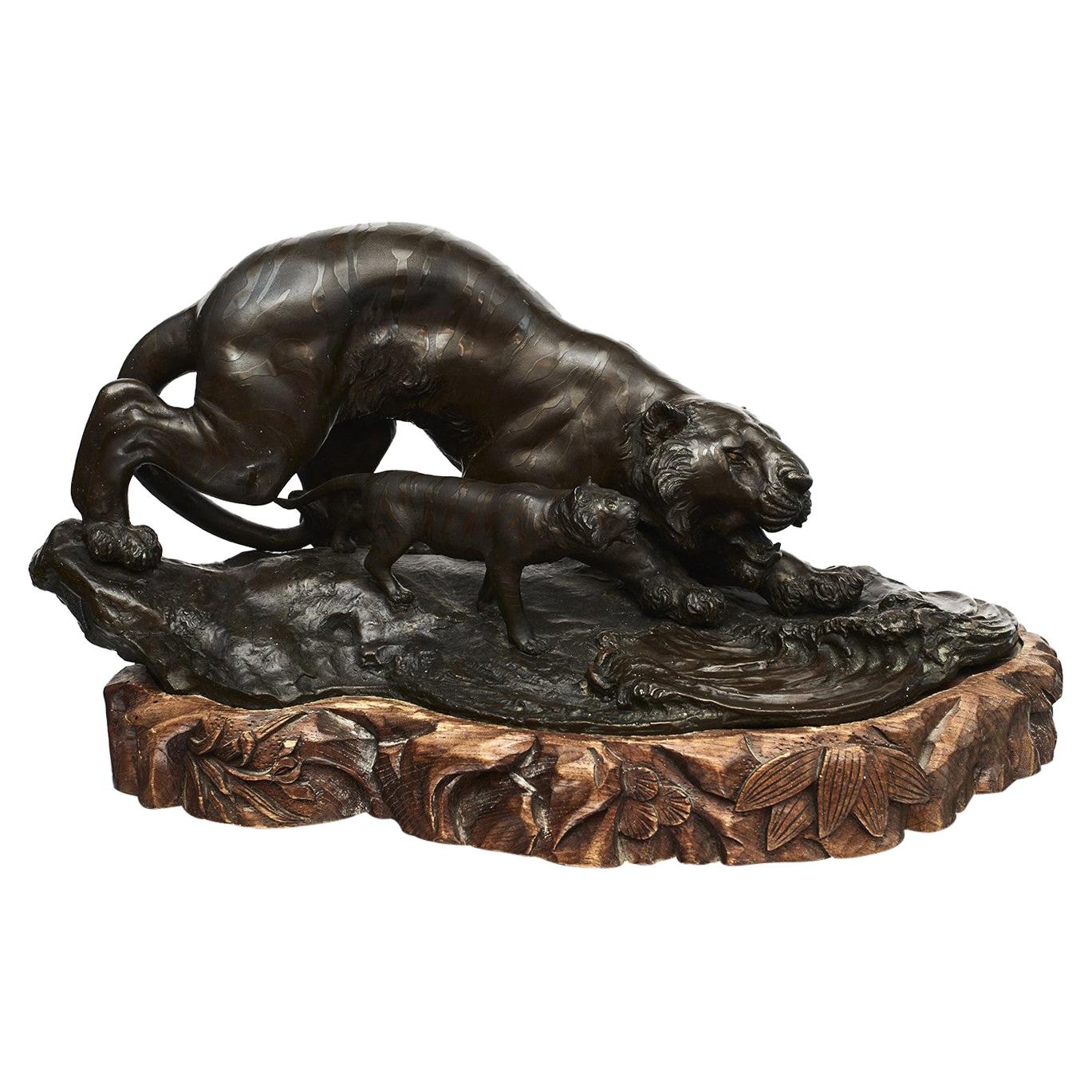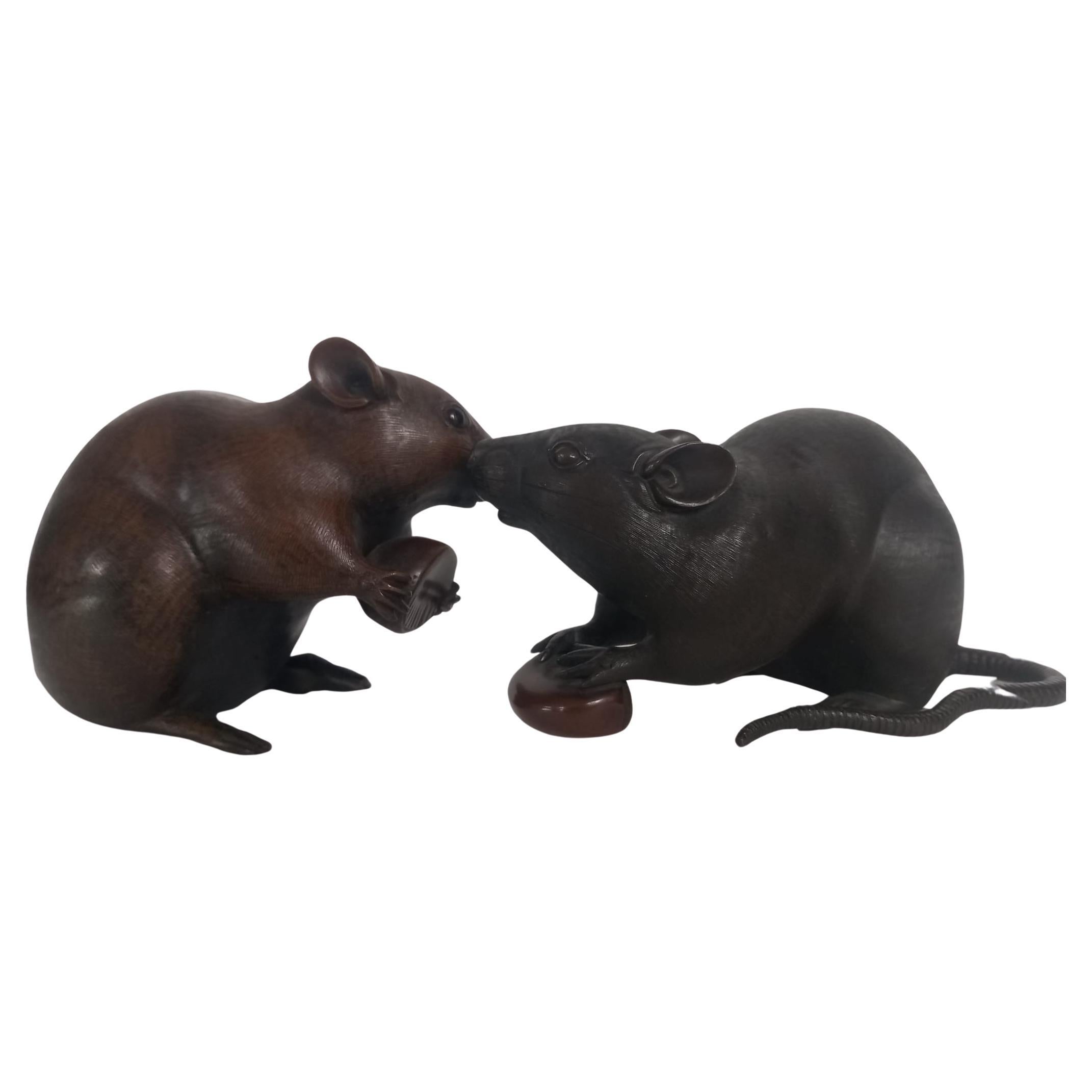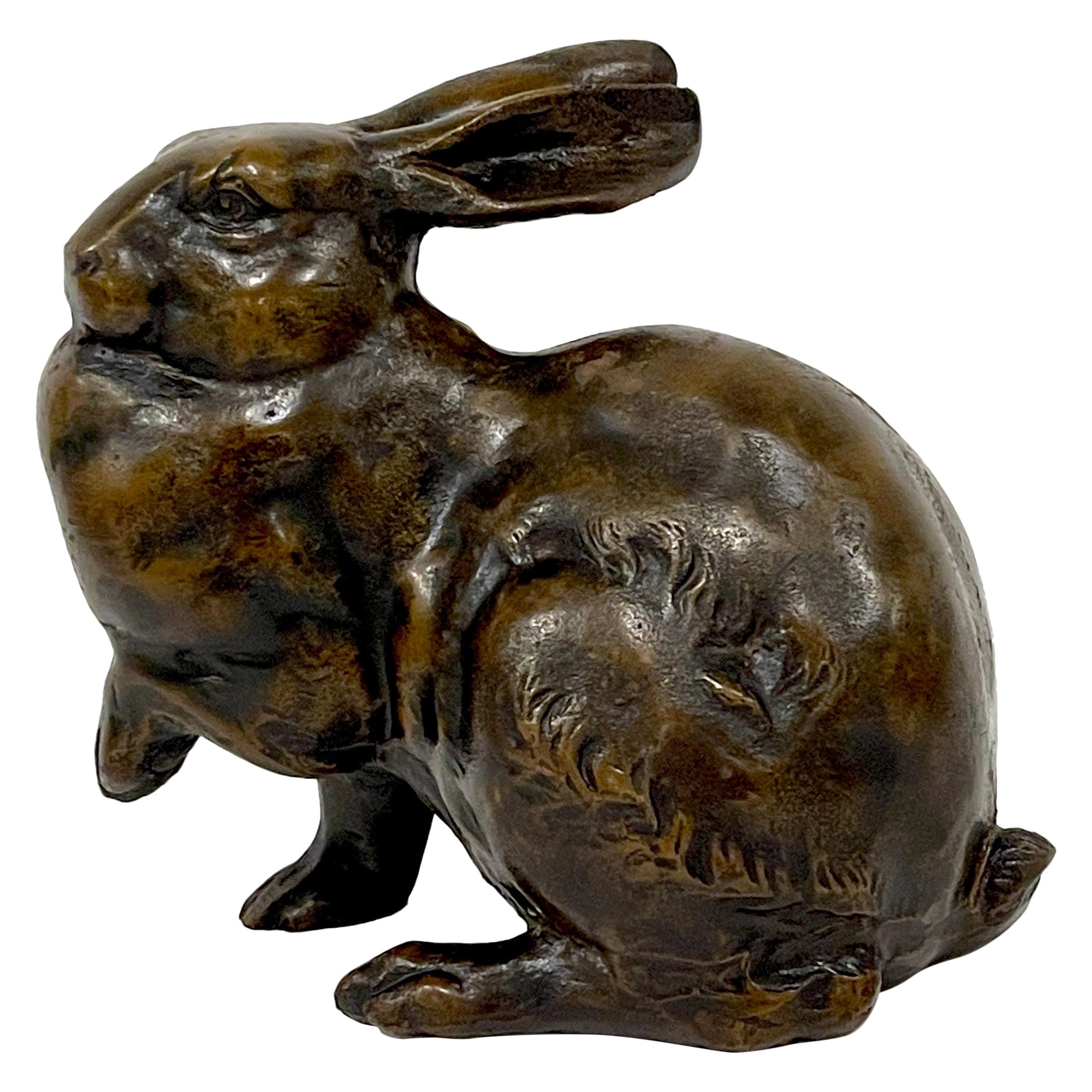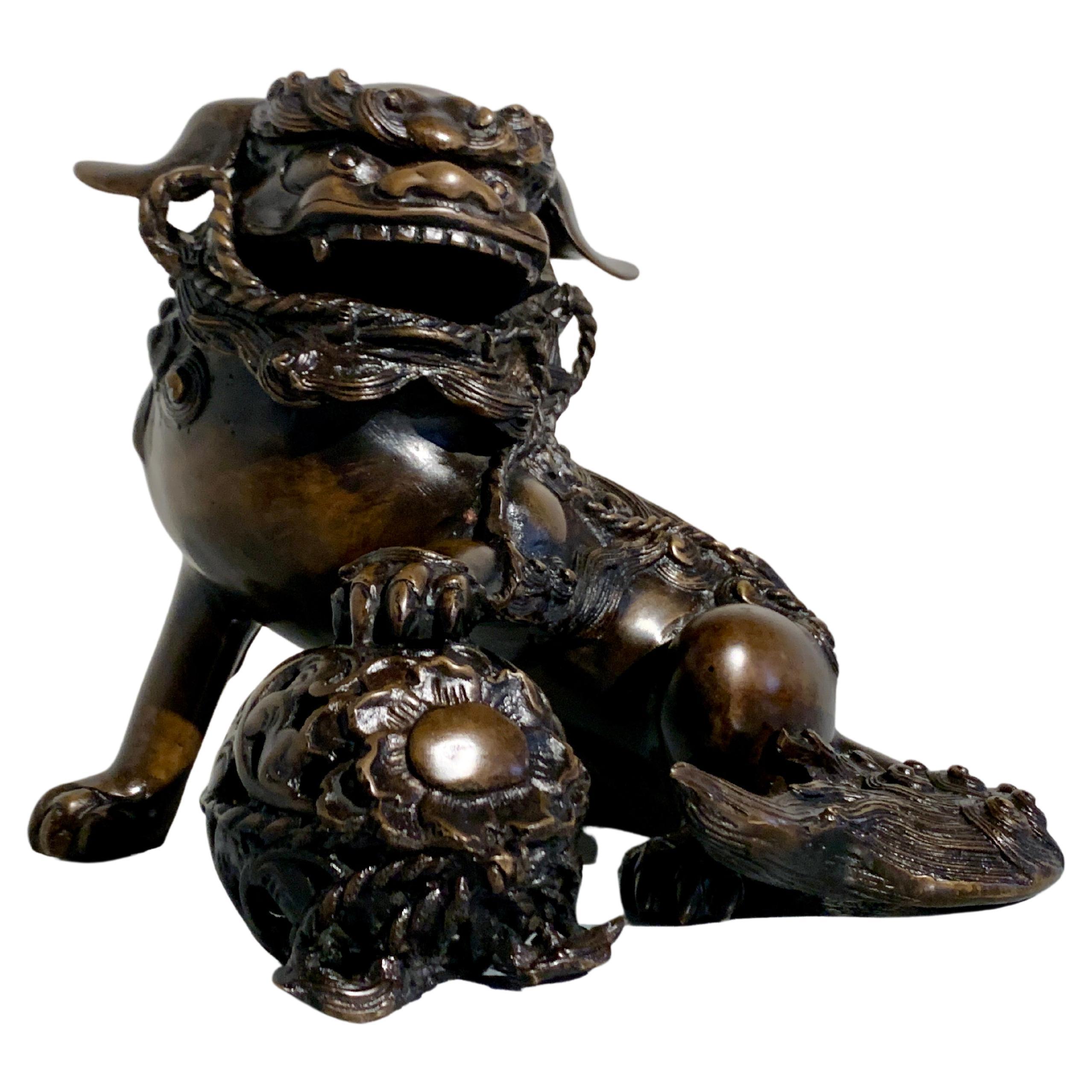Items Similar to Japanese Meiji Period Bronze Group Bear & Alligator by Yoshimitsu
Want more images or videos?
Request additional images or videos from the seller
1 of 12
Japanese Meiji Period Bronze Group Bear & Alligator by Yoshimitsu
About the Item
The Japanese group comprises of a Bear being attacked by a large alligator. The alligator jumping on the back of the Bear with mouth wide opening showing its razor sharp teeth. The bear looking back at the Alligator with mouth also wide open snarling at the attacking predator. The group of natural bronze casting with life like features to both the Bears fur and the scales of the Alligator. Signed on the belly of the Bear in a rectangle reserve 芳光作 Yoshimitsu-saku (made by Yoshimitsu). The group dates to the Meiji period (1868-1912) circa 1890. The Japanese group is stood upon a scrollwork foot wooden stand to emphasise the and lift the figure.
Meiji Period is an era of Japanese history that spanned from 1868 to 1912. It was the first half of the Empire of Japan, when the Japanese people began to build a paradigm of a modern, industrialised nation state and emergent great power, influenced by Western countries and aesthetics. As a result of radically different ideas, the changes to Japan were profound and it affected the social structure, politics, economy, military, and foreign relations across the board. The period corresponded to the reign of Emperor Meiji and was preceded by the Keio era and was succeeded by the Taisho era.
Cultural Art during the Meiji Period was of particular interest to the government and they overhauled the art export market which in turn promoted Japanese arts via various world’s fairs, beginning in Vienna at the world fair in 1873. The government heavily funded the fairs and took an active role organising how Japan’s culture was presented to the world including creating a semi-public company named Kiritsu Kosho Kaisha (First Industrial Manufacturing Company). The Kiritsu Kosho Kaisha was used to promote and commercialise exports of Japanese art and established the Hakurankai Jimukyoku (Exhibition Bureau) to maintain quality standards. For the 1876 Centennial International Exhibition in Philadelphia, the Japanese government created a Centennial Office and sent a special envoy to secure space for the 30,000 items that would be displayed. The Imperial Household also took an active interest in arts and crafts, commissioning works by select artists to be given as gifts for foreign dignitaries further emphasising the high quality and importance of Japanese art. Just before the end of the 19th century in 1890, the Teishitsu Gigeiin (Artist to the Imperial Household) system was created to recognise distinguished artists. These artists were selected for their exceptionally high quality wares and talent in their own industry. Over a period of 54 years Seventy artists were appointed, amongst these were ceramicist Makuzu Kozan and cloisonné enamel artist Namikawa Yasuyuki.
Bronze is an alloy consisting primarily of copper with approximately 12–12.5% tin and often with the addition of other metals (including aluminium, manganese, nickel, or zinc) and sometimes non-metals, such as phosphorus, or metalloids such as arsenic or silicon depending on the age of the bronze and its origin. The additions of other metals produce a range of alloys that are usually harder than copper alone and carry useful properties such as strength. The earliest known use of bronze dates to the 5th millennium BCE from Iranian plateau, the bronze mix consists of arsenical copper and copper-arsenide. The earliest tin-copper-alloy recovered is dated to circa 4650 BCE and was found in Plocnik, Serbia. It is believed to have been smelted from a natural tin-copper ore.
Measurements Figure 13cm High x 25.5cm Wide x 18cm Deep (5.12 x 10 x 7.1 Inches) Stand 3cm High x 32cm Wide x 22.5cm Deep (1.18 x 12.6 x 8.86 Inches)
- Dimensions:Height: 5.12 in (13.01 cm)Width: 10 in (25.4 cm)Depth: 7.1 in (18.04 cm)
- Style:Meiji (Of the Period)
- Materials and Techniques:
- Place of Origin:
- Period:
- Date of Manufacture:Circa 1890
- Condition:
- Seller Location:Newark, GB
- Reference Number:
About the Seller
5.0
Vetted Seller
These experienced sellers undergo a comprehensive evaluation by our team of in-house experts.
Established in 2019
1stDibs seller since 2022
18 sales on 1stDibs
Typical response time: 3 hours
- ShippingRetrieving quote...Ships From: Newark, United Kingdom
- Return PolicyA return for this item may be initiated within 14 days of delivery.
More From This SellerView All
- Japanese Meiji Period Carved Wood Okimono Man with RabbitsLocated in Newark, EnglandThe charming figure, carved from a single piece of wood is exceptionally carved showing the male figure with humorous expression holding two Rabbits one by the ears and the second under his arm. A third Rabbit stands at the feet of the male looking up, each rabbit with a different expression. The male figure is wearing traditional Japanese attire with his hair tied back stood upon a naturalistic base. The figure dates to the Meiji Period (1868-1912) circa 1900. Notes The Rabbit is one of the 12 animals to feature in the Japanese Zodiac signs which follows the Chinese astrological system along with the Rat, Ox, Tiger, Rabbit, Dragon, Snake, Horse, Goat, Monkey, Rooster, Dog, Pig. Such division is connected with the Jupiter cycle around the Sun, which lasts about 12 years. As 2023 is the year of the Rabbit...Category
Antique Early 1900s Japanese Meiji Sculptures and Carvings
MaterialsWood
- Japanese Bronze Vase Pair Meiji PeriodLocated in Newark, EnglandA fine large sized pair of Japanese bronze vases. The vases each surmounted by waisted necks flanked by two spreading handles with accents in the form of Japanese Torri (traditional ...Category
Antique Late 19th Century Japanese Meiji Metalwork
MaterialsMetal, Gold, Silver, Bronze, Copper
- Japanese Meiji Period Koi Carp Bronze BoxLocated in Newark, EnglandJapanese meiji period mixed metal box. The box formed in a kidney shape decorated with swimming koi carp fish throughout. Each koi with intricate detailing wi...Category
Antique Early 1900s Japanese Meiji Metalwork
MaterialsMetal, Gold, Bronze
- Japanese Meiji Period Satsuma Vase by KinkozanBy KinkozanLocated in Newark, EnglandThe vase is potted in globular form with a tightly pinched neck and rolled top rim beautifully decorated with four highly detailed individual panelled scenes. The first a Geisha bari...Category
Antique Late 19th Century Japanese Meiji Ceramics
MaterialsCeramic, Earthenware, Pottery
- Japanese Meiji Period Satsuma Floor VasesLocated in Newark, EnglandThe vases of large oval form potted from earthenware with pinched neck and base stood upon a splayed circular foot. The vases extensively decorated with a continuous scene with polychrome colours and raised enamels featuring a large central white elephant and various figures. The top and bottom bordered by arched gilt decoration and gilded rims. The bases signed by a three character mark in red 新井造 Arai Zo (made by Arai). The vases date to the Meiji period (1868-1912) and are large in size measuring 46cm High. Meiji Period is an era of Japanese history that spanned from 1868 to 1912. It was the first half of the Empire of Japan, when the Japanese people began to build a paradigm of a modern, industrialised nation state and emergent great power, influenced by Western countries and aesthetics. As a result of radically different ideas, the changes to Japan were profound and it affected the social structure, politics, economy, military, and foreign relations...Category
Antique Late 19th Century Japanese Meiji Vases
MaterialsCeramic, Earthenware
- Japanese Meiji Period Satsuma Bowl KinkozanBy KinkozanLocated in Newark, EnglandFrom our Japanese collection, we are delighted to offer this Japanese Meiji period Satsuma Bowl by Kinkozan. The earthenware bowl with pinched rim extensively decorated on both the exterior and interior. The bowl with a cobalt blue base glaze decorated to the borders with gilt shippo-tsunagi (linked-cash) with scattered medallion roundells. Around the exterior two elongated scenes are featured, one with boys playing games in a courtyard with the other featuring seated scholars in full dress both with raised enamel decoration. The interior features a central scene with Samurai warriors in training fully armoured with swords in a courtyard with landscapes scenes to the background. The central scene bordered by further stylised shippo-tsunagi type decoration with a greek key rim border. The bowl signed to the base Kinkozan dating to the Meiji Period (1868-1912) circa 1900. Shippo-Tsunagi (linked-cash) or seven treasures, is a traditional Japanese geometric pattern that combines four ellipses in a circle. These ellipses repeat outward to then create more circles, symbolising eternal peace and happiness. Kinkozan the Kinkozan family have been associated with pottery dating back to 1645. They went on to become the largest producer of Satsuma ware by one individual company, from the end of the 19th century until 1927 after which the factory closed. By the 1850s Kobayashi Sobei (1824-84), Kinkozan Sobei...Category
Antique Early 1900s Japanese Meiji Ceramics
MaterialsCeramic, Earthenware, Pottery, Faux Leather
You May Also Like
- Japanese Meiji Period Bronze Tiger with CubLocated in Kastrup, DKJapanese Meiji period (1868-1912) patinated bronze sculpture of a tiger with cub. Mounted on a carved hardwood base decorated with foliage. High...Category
Antique 19th Century Japanese Meiji Animal Sculptures
MaterialsBronze
- A Japanese bronze of two rats (Meiji Period)Located in London, GBSet contains two: A Japanese bronze of a rat, Meiji Period, signed, approximately 9cm long x 8cm high and another Japanese bronze of a rat, signed, seated on its back legs, brown pat...Category
Antique Late 19th Century Japanese Meiji Animal Sculptures
MaterialsBronze
- Meiji period bronzeLocated in Atlanta, GAVery fine Japanese bronze of two territorial beasts, on a decoratively carved teak base. The base is 34 inches long, the bronze is 29 inches long.Category
Antique Late 19th Century Japanese Meiji Sculptures
MaterialsBronze
- Japanese Bronze Meiji Period Bronze Sculpture of a Usagi (Rabbit)Located in West Palm Beach, FLJapanese Bronze Meiji Period Bronze Sculpture of a Usagi (Rabbit) Japan, Circa 1900 Immerse yourself to the elegance of Meiji-era Japan with this stunning bronze sculpture depictin...Category
Early 20th Century Japanese Meiji Animal Sculptures
MaterialsBronze
- Japanse Bronze Shishi Foo Lion by Shuzan / Hideyama, Meiji period, JapanLocated in Austin, TXA heavy and powerfully cast Japanese bronze model of a shishi or foo lion by Hideyama / Shuzan, Meiji Period, circa 1900, Japan. The dramatic lion, known as a shishi in Japan, is ca...Category
Antique Early 1900s Japanese Meiji Animal Sculptures
MaterialsBronze
- Pair of Japanese Gilt Bronze Komainu by Ishikawa Komei, Meiji PeriodLocated in Austin, TXA striking pair of Japanese gilt bronze komainu by the renowned Japanese sculptor, Ishikawa Komei (1852-1913), Meiji period, Japan. The pair well cast, and robustly modeled. They ar...Category
Antique Late 19th Century Japanese Meiji Sculptures and Carvings
MaterialsBronze
Recently Viewed
View AllMore Ways To Browse
Hand Carved Bear Sculpture
Arts Crafts Bureau
Bronze Alligator Sculpture
Alligator Items
Political Interest
Japanese Metal Bronzes
Razor Stand
Wooden Stands For Display Items
Alligator Teeth
Alligator Art
Philadelphia Empire
Belly Board
Millennium Furniture
Brienz Carved Cow
Anette Edmark
Ceramic Angelfish
Horse Phidias
Alvino Bagni Cat





